Radon Dynamics in Granite and Calcareous Soils: Long-Term Experiments in a Semi-Arid Context
Abstract
1. Introduction
2. Materials and Methods
2.1. Weather Variables and Climate Series
2.2. Soil Properties
2.3. Monitoring System
2.4. Sampling System
2.5. Artificial Soil Water Content Experiment
2.6. Time Series Analysis
3. Results
3.1. Time Evolution of the Radon Activity and the Main Weather Parameters
3.1.1. Granite Soil
3.1.2. Calcareous Soil
3.2. Influence of Weather and Soil Parameters on Radon Dynamics
3.3. Artificial Soil Water Content Experiment
4. Discussion
4.1. Time Series Analyses
4.1.1. Statistical Analyses of the Granite Soil
4.1.2. Statistical Analyses of the Calcareous Soil
4.1.3. Wavelets
4.2. Radon Potential
5. Conclusions
Author Contributions
Funding
Institutional Review Board Statement
Informed Consent Statement
Data Availability Statement
Acknowledgments
Conflicts of Interest
References
- Barbosa, S.M.; Donner, R.V.; Steinitz, G. Radon Applications in Geosciences—Progress & Perspectives. Eur. Phys. J. Spec. Top. 2015, 224, 597–603. [Google Scholar]
- Neri, M.; Ferrera, E.; Giammanco, S.; Currenti, G.; Cirrincione, R.; Patanè, G.; Zanon, V. Soil Radon Measurements as a Potential Tracer of Tectonic and Volcanic Activity. Sci. Rep. 2016, 6, 24581. [Google Scholar] [CrossRef] [PubMed][Green Version]
- Galiana-Merino, J.J.; Molina, S.; Kharazian, A.; Toader, V.E.; Moldovan, I.A.; Gómez, I. Analysis of Radon Measurements in Relation to Daily Seismic Activity Rates in the Vrancea Region, Romania. Sensors 2022, 22, 4160. [Google Scholar] [CrossRef] [PubMed]
- World Health Organization. WHO Handbook on Indoor Radon: A Public Health Perspective; Zeeb, H., Shannoun, F., Eds.; WHO Press: Geneva, Switzerland, 2009; ISBN 9789241547673. [Google Scholar]
- Darby, S.; Hill, D.; Auvinen, A.; Barros-Dios, J.M.; Baysson, H.; Bochicchio, F.; Deo, H.; Falk, R.; Forastiere, F.; Hakama, M.; et al. Radon in Homes and Risk of Lung Cancer: Collaborative Analysis of Individual Data from 13 European Case-Control Studies. Br. Med. J. 2005, 330, 223. [Google Scholar] [CrossRef] [PubMed]
- Riudavets, M.; Garcia de Herreros, M.; Besse, B.; Mezquita, L. Radon and Lung Cancer: Current Trends and Future Perspectives. Cancers 2022, 14, 3142. [Google Scholar] [CrossRef] [PubMed]
- Neznal, M.; Neznal, M.; Matolín, M.; Barnet, I.; Miksova, J. The New Method for Assessing the Radon Risk of Building Sites; Czech Geological Survey: Prague, Czech Republic, 2004.
- Beltrán-Torres, S.; Szabó, K.Z.; Tóth, G.; Tóth-Bodrogi, E.; Kovács, T.; Szabó, C. Estimated versus Field Measured Soil Gas Radon Concentration and Soil Gas Permeability. J. Environ. Radioact. 2023, 265, 107224. [Google Scholar] [CrossRef] [PubMed]
- Gruber, V.; Bossew, P.; De Cort, M.; Tollefsen, T. The European Map of the Geogenic Radon Potential. J. Radiol. Prot. 2013, 33, 51–60. [Google Scholar] [CrossRef] [PubMed]
- García-Talavera San Miguel, M.; López Acevedo, F.J. Cartografía Del Potencial de Radón de España; Colección Informes Técnicos 51.2019; Consejo de Seguridad Nuclear: Madrid, Spain, 2019. [Google Scholar]
- Elío, J.; Crowley, Q.; Scanlon, R.; Hodgson, J.; Long, S. Logistic Regression Model for Detecting Radon Prone Areas in Ireland. Sci. Total Environ. 2017, 599–600, 1317–1329. [Google Scholar] [CrossRef] [PubMed]
- European Commission; Joint Research Centre. European Atlas of Natural Radiation; Cinelli, G., De Cort, M., Tollefsen, T., Eds.; Publication Office of the European Union: Luxembourg, 2019; ISBN 9789276082590. [Google Scholar]
- Petersell, V.; Täht-Kok, K.; Karimov, M.; Milvek, H.; Nirgi, S.; Raha, M.; Saarik, K. Radon in the Soil Air of Estonia. J. Environ. Radioact. 2017, 166, 235–241. [Google Scholar] [CrossRef]
- Benavente, D.; Valdés-Abellán, J.; Pla, C.; Sanz-Rubio, E. Estimation of Soil Gas Permeability for Assessing Radon Risk Using Rosetta Pedotransfer Function Based on Soil Texture and Water Content. J. Environ. Radioact. 2019, 208–209, 105992. [Google Scholar] [CrossRef]
- Aydar, E.; Diker, C. Carcinogen Soil Radon Enrichment in a Geothermal Area: Case of Güzelçamlı-Davutlar District of Aydın City, Western Turkey. Ecotoxicol. Environ. Saf. 2021, 208, 111466. [Google Scholar] [CrossRef] [PubMed]
- Nicolas, A.; Girault, F.; Schubnel, A.; Pili, É.; Passelègue, F.; Fortin, J.; Deldicque, D. Radon Emanation from Brittle Fracturing in Granites under Upper Crustal Conditions. Geophys. Res. Lett. 2014, 41, 5436–5443. [Google Scholar] [CrossRef]
- Sêco, S.L.R.; Domingos, F.P.; Pereira, A.J.S.C.; Duarte, L.V. Estimation of the Radon Production Potential in Sedimentary Rocks: A Case Study in the Lower and Middle Jurassic of the Lusitanian Basin (Portugal). J. Environ. Radioact. 2020, 220–221, 106272. [Google Scholar] [CrossRef] [PubMed]
- Flexser, S.; Wollenberg, H.A.; Smith, A.R. Distribution of Radon Sources and Effects on Radon Emanation in Granitic Soil at Ben Lomond, California. Environ. Geol. 1993, 22, 162–177. [Google Scholar] [CrossRef]
- Pla, C.; Cuezva, S.; Martinez-Martinez, J.; Fernandez-Cortes, A.; Garcia-Anton, E.; Fusi, N.; Crosta, G.B.; Cuevas-Gonzalez, J.; Cañaveras, J.C.; Sanchez-Moral, S.; et al. Role of Soil Pore Structure in Water Infiltration and CO2 Exchange between the Atmosphere and Underground Air in the Vadose Zone: A Combined Laboratory and Field Approach. Catena 2017, 149, 402–416. [Google Scholar] [CrossRef]
- Benavente, D.; Pla, C. Effect of Pore Structure and Moisture Content on Gas Diffusion and Permeability in Porous Building Stones. Mater. Struct./Mater. Constr. 2018, 51, 21. [Google Scholar] [CrossRef]
- Chitra, N.; Bala Sundar, S.; Inigo Valan, I.; Subramanian, V.; Jose, M.T.; Venkatraman, B. Modeling and Experiments to Estimate Radon Emanation Factor in Soil-Grain Size and Moisture Effect. Radiat. Prot. Dosim. 2021, 194, 104–112. [Google Scholar] [CrossRef] [PubMed]
- Scanlon, B.R.; Nicot, J.P.; Massmann, J.W. Soil Gas Movement in Unsaturated Systems. In Soil Physics Companion; Warrick, A.W., Ed.; CRC Press: Boca Raton, FL, USA, 2002. [Google Scholar]
- Schery, S.D.; Gaeddert, D.H.; Wilkening, M.H. Factors Affecting Exhalation of Radon from Gravelly a Gravelly Sandy Loam. J. Geophys. Res. 1984, 89, 7299–7309. [Google Scholar] [CrossRef]
- Sun, K.; Guo, Q.; Cheng, J. The Effect of Some Soil Characteristics on Soil Radon Concentration and Radon Exhalation from Soil Surface. J. Nucl. Sci. Technol. 2004, 41, 1113–1117. [Google Scholar] [CrossRef]
- Thomas, P.A.; Anderson, D.W.; Zhang, W.; Baweja, A.S.; Tracy, B.L. Radon Emanation in Saskatchewan Soils. Health Phys. 2011, 100, 565–573. [Google Scholar] [CrossRef]
- Ohno, M.; Okamoto, K.; Umegaki, K.; Fujiyoshi, R. Results of Simultaneous Monitoring of Soil 222Rn and Moisture at Different Depths in a Forest Site in Fukushima Prefecture, Japan. J. Radioanal. Nucl. Chem. 2016, 310, 1013–1020. [Google Scholar] [CrossRef]
- Ubeid, K.F.; Ramadan, K.A. Soil Types and Their Relations with Radon Concentration Levels in Middle Governorate of Gaza Strip, Palestine. Pol. J. Soil Sci. 2020, 53, 56–72. [Google Scholar] [CrossRef]
- Asher-Bolinder, S.; Owen, D.E.; Schumann, R.R. Pedologic and Climatic Controls on RN-222 Concentrations in Soil Gas, Denver, Colorado. Geophys. Res. Lett. 1990, 17, 825–828. [Google Scholar] [CrossRef]
- Tchorz-Trzeciakiewicz, D.E.; Rysiukiewicz, M. Ambient Gamma Dose Rate as an Indicator of Geogenic Radon Potential. Sci. Total Environ. 2021, 755, 142771. [Google Scholar] [CrossRef] [PubMed]
- Gil-Oncina, S.; Valdes-Abellan, J.; Pla, C.; Benavente, D. Estimation of the Radon Risk Under Different European Climates and Soil Textures. Front. Public Health 2022, 10, 794557. [Google Scholar] [CrossRef]
- Jackson, R.D. Diurnal Changes in Soil Water Content during Drying. In Field Soil Water Regime; Wiley: Hoboken, NJ, USA, 2015; pp. 37–55. ISBN 9780891189008. [Google Scholar]
- Thomas, D.M.; Cotier, J.M.; Holford, D. Experimental Design for Soil Gas Radon Monitoring. J. Radioanal. Nucl. Chem. 1992, 161, 313–323. [Google Scholar] [CrossRef]
- Siino, M.; Scudero, S.; Cannelli, V.; Piersanti, A.; D’Alessandro, A. Multiple Seasonality in Soil Radon Time Series. Sci. Rep. 2019, 9, 8610. [Google Scholar] [CrossRef] [PubMed]
- Gavriliev, S.; Petrova, T.; Miklyaev, P. Factors Influencing Radon Transport in the Soils of Moscow. Environ. Sci. Pollut. Res. 2022, 29, 88606–88617. [Google Scholar] [CrossRef]
- Voltaggio, M. Radon Progeny in Hydrometeors at the Earth’s Surface. Radiat. Prot. Dosim. 2012, 150, 334–341. [Google Scholar] [CrossRef] [PubMed]
- Sakoda, A.; Ishimori, Y.; Yamaoka, K. A Comprehensive Review of Radon Emanation Measurements for Mineral, Rock, Soil, Mill Tailing and Fly Ash. Appl. Radiat. Isot. 2011, 69, 1422–1435. [Google Scholar] [CrossRef]
- Rey, N.G.; Dlott, D.D. Effects of Water on Low-Overpotential CO2 Reduction in Ionic Liquid Studied by Sum-Frequency Generation Spectroscopy. Phys. Chem. Chem. Phys. 2017, 19, 10491–10501. [Google Scholar] [CrossRef]
- Fujiyoshi, R.; Haraki, Y.; Sumiyoshi, T.; Amano, H.; Kobal, I.; Vaupotič, J. Tracing the Sources of Gaseous Components (222Rn, CO2 and Its Carbon Isotopes) in Soil Air under a Cool-Deciduous Stand in Sapporo, Japan. Environ. Geochem. Health 2010, 32, 73–82. [Google Scholar] [CrossRef] [PubMed]
- van der Laan, S.; van der Laan-Luijkx, I.T.; Zimmermann, L.; Conen, F.; Leuenberger, M. Net CO2 Surface Emissions at Bern, Switzerland Inferred from Ambient Observations of CO2, δ(O2/N2), and 222Rn Using a Customized Radon Tracer Inversion. J. Geophys. Res. 2014, 119, 1580–1591. [Google Scholar] [CrossRef]
- Amundson, R.; Stern, L.; Baisden, T.; Wang, Y. The Isotopic Composition of Soil and Soil-Respired CO2. Geoderma 1998, 82, 83–114. [Google Scholar] [CrossRef]
- Malczewski, D.; Żaba, J. 222Rn and 220Rn Concentrations in Soil Gas of the Izera Massif (Sudetes, Poland) as a Function of Sampling Depth. Geol. Q. 2017, 61, 877–886. [Google Scholar] [CrossRef][Green Version]
- Moreno, V.; Bach, J.; Font, L.; Baixeras, C.; Zarroca, M.; Linares, R.; Roqué, C. Soil Radon Dynamics in the Amer Fault Zone: An Example of Very High Seasonal Variations. J. Environ. Radioact. 2016, 151, 293–303. [Google Scholar] [CrossRef] [PubMed]
- Seyis, C.; İnan, S.; Yalçın, M.N. Major Factors Affecting Soil Radon Emanation. Nat. Hazards 2022, 114, 2139–2162. [Google Scholar] [CrossRef]
- Pulinets, S.; Mironova, I.; Miklyaev, P.; Petrova, T.; Shitov, A.; Karagodin, A. Radon Variability as a Result of Interaction with the Environment. Atmosphere 2024, 15, 167. [Google Scholar] [CrossRef]
- Papachristodoulou, C.; Stamoulis, K.; Ioannides, K. Temporal Variation of Soil Gas Radon Associated with Seismic Activity: A Case Study in NW Greece. Pure Appl. Geophys. 2019, 177, 821–836. [Google Scholar] [CrossRef]
- Haquin, G.; Zafrir, H.; Ilzycer, D.; Weisbrod, N. Effect of Atmospheric Temperature on Underground Radon: A Laboratory Experiment. J. Environ. Radioact. 2022, 253–254, 106992. [Google Scholar] [CrossRef]
- Nassiri-Mofakham, N.; Kakaei, M.; Alavi, M. A Study on Radon Diffusion and Exhalation of Soils under Transient Conditions: Theoretical and Experimental Approach. Appl. Radiat. Isot. 2023, 192, 110616. [Google Scholar] [CrossRef] [PubMed]
- Papachristodoulou, C.; Ioannides, K.; Spathis, S. The Effect of Moisture Content on Radon Diffusion through Soil: Assessment in Laboratory and Field Experiments. Health Phys. 2007, 92, 257–264. [Google Scholar] [CrossRef] [PubMed]
- Chazarra Bernabé, A.; Lorenzo Mariño, B.; Romero Fresneda, R.; Moreno García, J.V. Evolución de Los Climas de Köppen en España en el Periodo 1951–2020; Agencia Estatal de Meteorología: Madrid, Spain, 2022.
- ISO 17892-4:2016; Investigación y Ensayos Geotécnicos. Ensayos de Laboratorio de Suelos. Parte 4: Determinación de La Distribución Granulométrica. Asociación Española de Normalización (UNE): Madrid, Spain, 2019.
- Topp, G.C.; Davis, J.L.; Annan, A.P. Electromagnetic Determination of Soil Water Content: Measurements in Coaxial Transmission Lines. Water Resour. Res. 1980, 16, 574–582. [Google Scholar] [CrossRef]
- Alonso Hernández, H. El Radón En Suelos, Rocas, Materiales de Construcción y Aguas. Doctoral Thesis, Universidad de Las Palmas de Gran Canaria, Las Palmas, Spain, 2016. [Google Scholar]
- Daubechies, I. Ten Lectures on Wavelets. Math. Comput. 1993, 61, 941–942. [Google Scholar] [CrossRef]
- Kaiser, G. A Friendly Guide to Wavelets; Birkhäuser: Boston, MA, USA, 2011. [Google Scholar]
- Wickerhauser, M.V. Adapted Wavelet Analysis from Theory to Software. SIAM Rev. 1996, 38, 160. [Google Scholar] [CrossRef]
- Strang, G.; Nguyen, T. Wavelets and Filter Banks; Wellesley-Cambridge Press: Wellesley, MA, USA, 1997; ISBN 0-9614088-7-1. [Google Scholar]
- D’Alessandro, A.; Scudero, S.; Siino, M.; Alessandro, G.; Mineo, R. Long-Term Monitoring and Characterization of Soil Radon Emission in a Seismically Active Area. Geochem. Geophys. Geosyst. 2020, 21, e2020GC009061. [Google Scholar] [CrossRef]
- Galiana-Merino, J.J.; Pla, C.; Fernandez-Cortes, A.; Cuezva, S.; Ortiz, J.; Benavente, D. EnvironmentalWaveletTool: Continuous and Discrete Wavelet Analysis and Filtering for Environmental Time Series. Comput. Phys. Commun. 2014, 185, 2758–2770. [Google Scholar] [CrossRef]
- Grinsted, A.; Moore, J.C.; Jevrejeva, S. Application of the Cross Wavelet Transform and Wavelet Coherence to Geophysical Time Series. Nonlinear Process Geophys. 2004, 11, 561–566. [Google Scholar] [CrossRef]
- Arvela, H.; Holmgren, O.; Hänninen, P. Effect of Soil Moisture on Seasonalvariation in Indoor Radon Concentration: Modelling and Measurements in 326 Finnish Houses. Radiat. Prot. Dosim. 2016, 168, 277–290. [Google Scholar] [CrossRef]
- İnan, S.; Kop, A.; Çetin, H.; Kulak, F.; Pabuçcu, Z.; Seyis, C.; Ergintav, S.; Tan, O.; Saatçılar, R.; Bodur, M.N. Seasonal Variations in Soil Radon Emanation: Long-Term Continuous Monitoring in Light of Seismicity. Natural Hazards 2012, 62, 575–591. [Google Scholar] [CrossRef]
- Miklyaev, P.S.; Petrova, T.B.; Shchitov, D.V.; Sidyakin, P.A.; Murzabekov, M.A.; Tsebro, D.N.; Marennyy, A.M.; Nefedov, N.A.; Gavriliev, S.G. Radon Transport in Permeable Geological Environments. Sci. Total Environ. 2022, 852, 158382. [Google Scholar] [CrossRef] [PubMed]
- Pinault, J.L.; Baubron, J.C. Signal Processing of Soil Gas Radon, Atmospheric Pressure, Moisture, and Soil Temperature Data: A New Approach for Radon Concentration Modeling. J. Geophys. Res. Solid Earth 1996, 101, 3157–3171. [Google Scholar] [CrossRef]
- Tareen, A.D.K.; Nadeem, M.S.A.; Kearfott, K.J.; Abbas, K.; Khawaja, M.A.; Rafique, M. Descriptive Analysis and Earthquake Prediction Using Boxplot Interpretation of Soil Radon Time Series Data. Appl. Radiat. Isot. 2019, 154, 108861. [Google Scholar] [CrossRef] [PubMed]
- Naskar, A.K.; Akhter, J.; Gazi, M.; Mondal, M.; Deb, A. Impact of Meteorological Parameters on Soil Radon at Kolkata, India: Investigation Using Machine Learning Techniques. Environ. Sci. Pollut. Res. 2023, 30, 105374–105386. [Google Scholar] [CrossRef] [PubMed]
- Chen, J.; Falcomer, R.; Ly, J.; Wierdsma, J.; Bergman, L. Long-Term Monitoring of Soil Gas Radon and Permeability at Two Reference Sites. Radiat. Prot. Dosim. 2008, 131, 503–508. [Google Scholar] [CrossRef] [PubMed]
- Font, L.; Baixeras, C.; Moreno, V.; Bach, J. Soil Radon Levels across the Amer Fault. Radiat. Meas. 2008, 43, S319–S323. [Google Scholar] [CrossRef]
- Kulali, F.; Akkurt, I.; Özgür, N. The Effect of Meteorological Parameters on Radon Concentration in Soil Gas. Acta Phys. Pol. A 2017, 132, 999–1001. [Google Scholar] [CrossRef]
- Blazewicz, S.J.; Schwartz, E.; Firestone, M.K. Growth and Death of Bacteria and Fungi Underlie Rainfall-Induced Carbon Dioxide Pulses from Seasonally Dried Soil. Ecology 2014, 95, 1162–1172. [Google Scholar] [CrossRef] [PubMed]
- Tan, S.; Ni, X.; Yue, K.; Liao, S.; Wu, F. Increased Precipitation Differentially Changed Soil CO2 Efflux in Arid and Humid Areas. Geoderma 2021, 388, 114946. [Google Scholar] [CrossRef]
- Sakoda, A.; Ishimori, Y.; Hanamoto, K.; Kataoka, T.; Kawabe, A.; Yamaoka, K. Experimental and Modeling Studies of Grain Size and Moisture Content Effects on Radon Emanation. Radiat. Meas. 2010, 45, 204–210. [Google Scholar] [CrossRef]
- Dhar, S.; Randhawa, S.S.; Kumar, A.; Walia, V.; Fu, C.C.; Bharti, H.; Kumar, A. Decomposition of Continuous Soil–Gas Radon Time Series Data Observed at Dharamshala Region of NW Himalayas, India for Seismic Studies. J. Radioanal. Nucl. Chem. 2021, 327, 1019–1035. [Google Scholar] [CrossRef]
- Yakut, H.; Tabar, E.; Yildirim, E.; Zenginerler, Z.; Ertugral, F.; Demirci, N. Soil Gas Radonmeasurement around Fault Lines on the Western Section of the North Anatolian Fault Zone in Turkey. Radiat. Prot. Dosim. 2017, 173, 405–413. [Google Scholar] [CrossRef]
- Piersanti, A.; Cannelli, V.; Galli, G. The Pollino 2012 Seismic Sequence: Clues from Continuous Radon Monitoring. Solid Earth 2016, 7, 1303–1316. [Google Scholar] [CrossRef]
- Turk, M.; Volarić, B.; Antolković, B. Radon Activity Concentration in the Ground and Its Correlation with the Water Content of the Soil. Appl. Radiat. Isot. 1996, 47, 377–381. [Google Scholar] [CrossRef]
- Perrier, F.; Girault, F. Harmonic Response of Soil Radon-222 Flux and Concentration Induced by Barometric Oscillations. Geophys. J. Int. 2013, 195, 945–971. [Google Scholar] [CrossRef]
- Bossew, P.; Cinelli, G.; Ciotoli, G.; Crowley, Q.G.; de Cort, M.; Medina, J.E.; Gruber, V.; Petermann, E.; Tollefsen, T. Development of a Geogenic Radon Hazard Index—Concept, History, Experiences. Int. J. Environ. Res. Public Health 2020, 17, 4134. [Google Scholar] [CrossRef] [PubMed]
- Åkerblom, G. Ground Radon: Monitoring Procedures in Sweden. In Proceedings of the Radon Workshop, Geology, Environment, Technology, London, UK, 12 February 1993. [Google Scholar]
- Giustini, F.; Ciotoli, G.; Rinaldini, A.; Ruggiero, L.; Voltaggio, M. Mapping the Geogenic Radon Potential and Radon Risk by Using Empirical Bayesian Kriging Regression: A Case Study from a Volcanic Area of Central Italy. Sci. Total Environ. 2019, 661, 449–464. [Google Scholar] [CrossRef] [PubMed]
- Voltaggio, M.; Masi, U.; Spadoni, M.; Zampetti, G. A Methodology for Assessing the Maximum Expected Radon Flux from Soils in Northern Latium (Central Italy). Environ. Geochem. Health 2006, 28, 541–551. [Google Scholar] [CrossRef] [PubMed]
- Zhuo, W.; Iida, T.; Furukawa, M. Modeling Radon Flux Density from the Earth’s Surface. J. Nucl. Sci. Technol. 2006, 43, 479–482. [Google Scholar] [CrossRef]
- Zhuo, W.; Guo, Q.; Chen, B.; Cheng, G. Estimating the Amount and Distribution of Radon Flux Density from the Soil Surface in China. J. Environ. Radioact. 2008, 99, 1143–1148. [Google Scholar] [CrossRef]
- Mualem, Y. A New Model for Predicting the Hydraulic Conductivity of Unsaturated Porous Media. Water Resour. Res. 1976, 12, 513–522. [Google Scholar] [CrossRef]
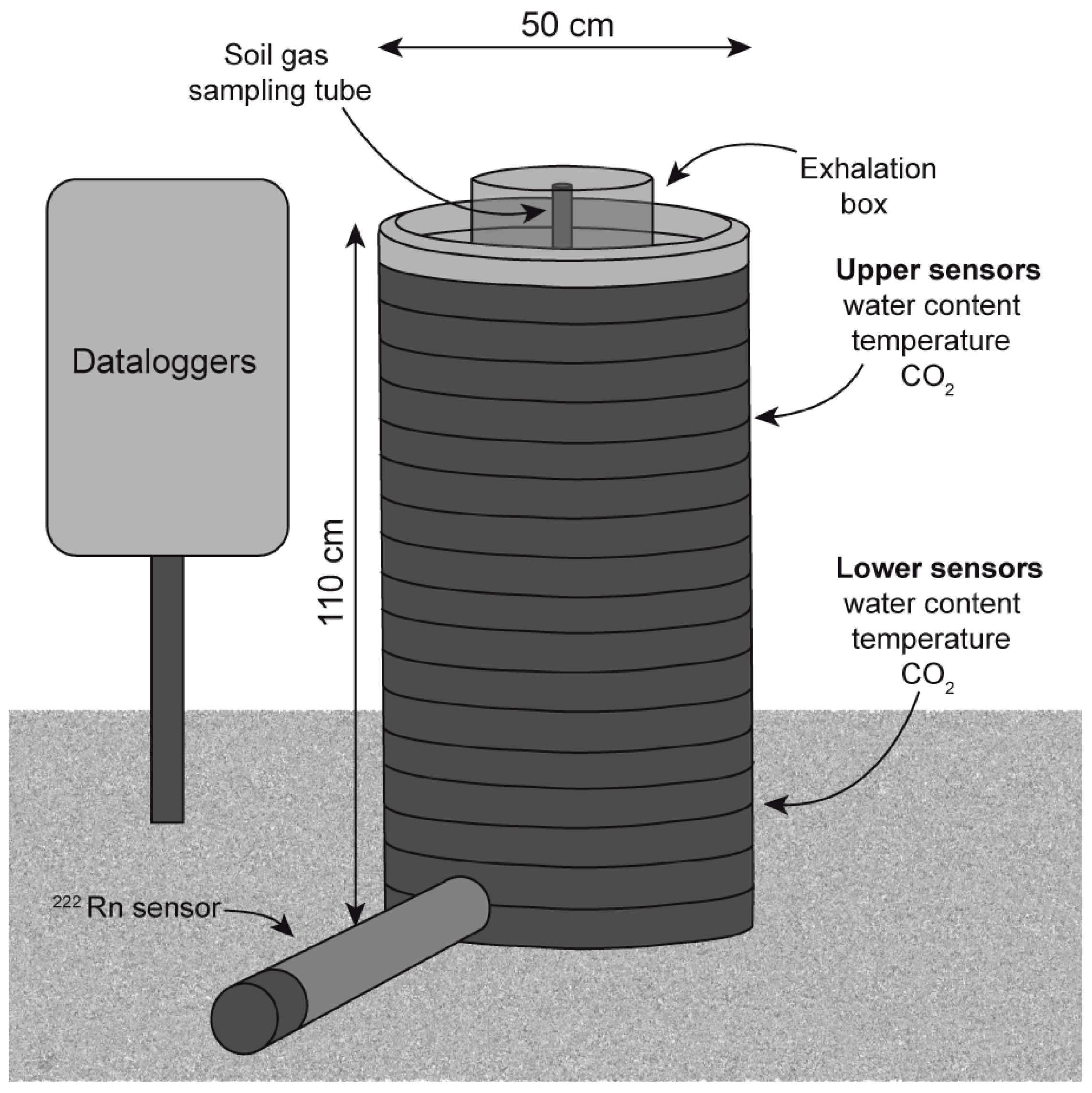

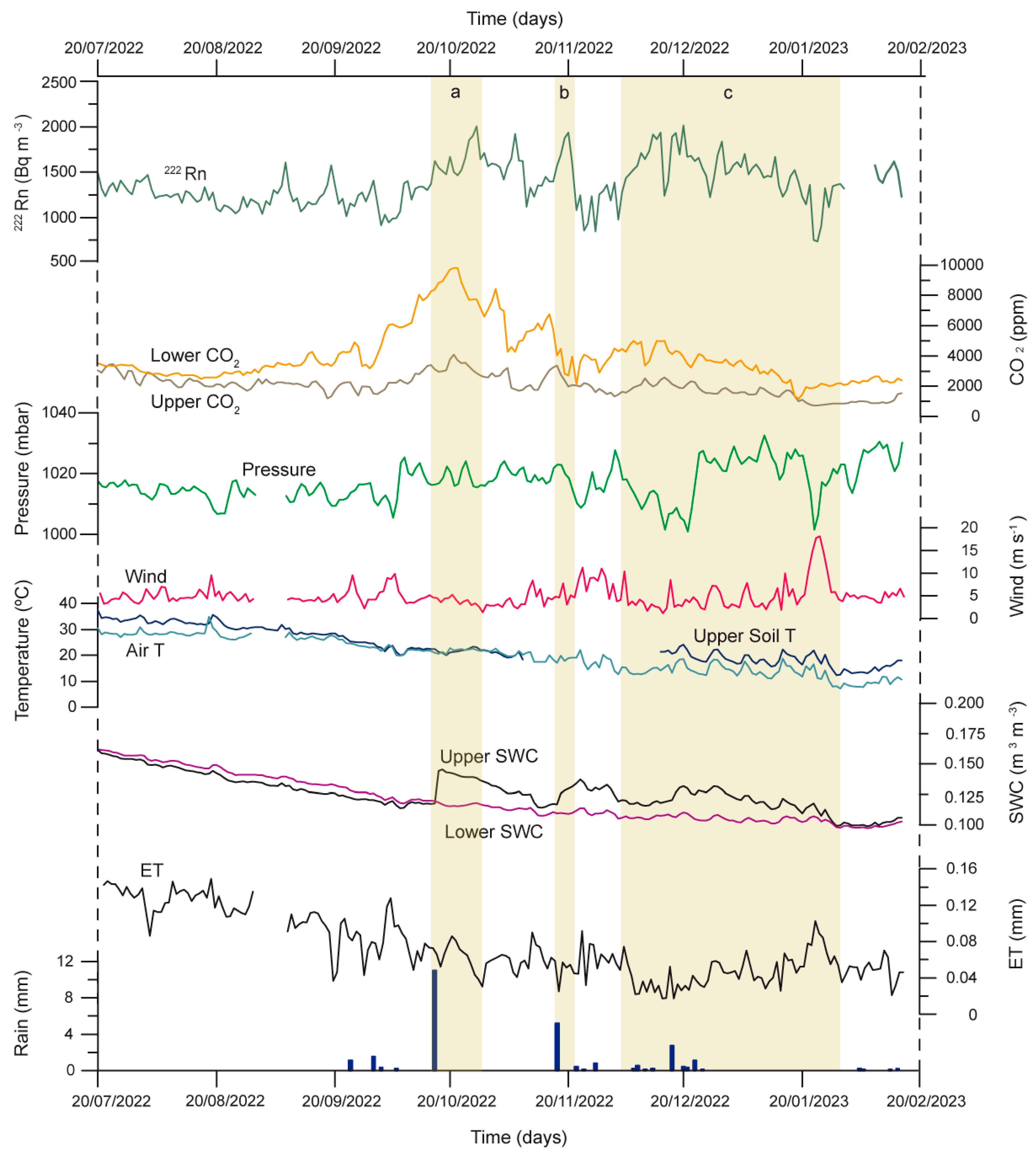

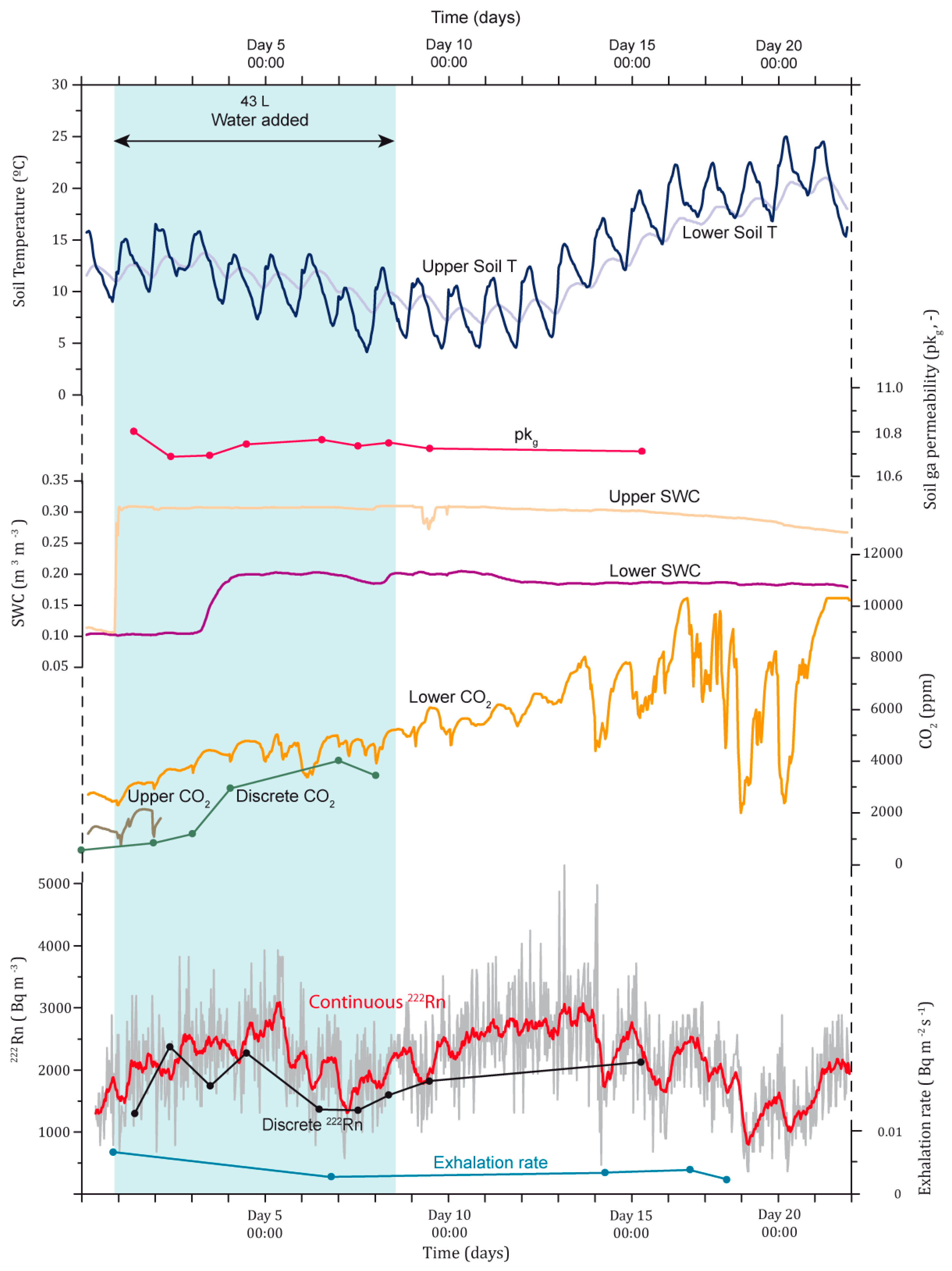
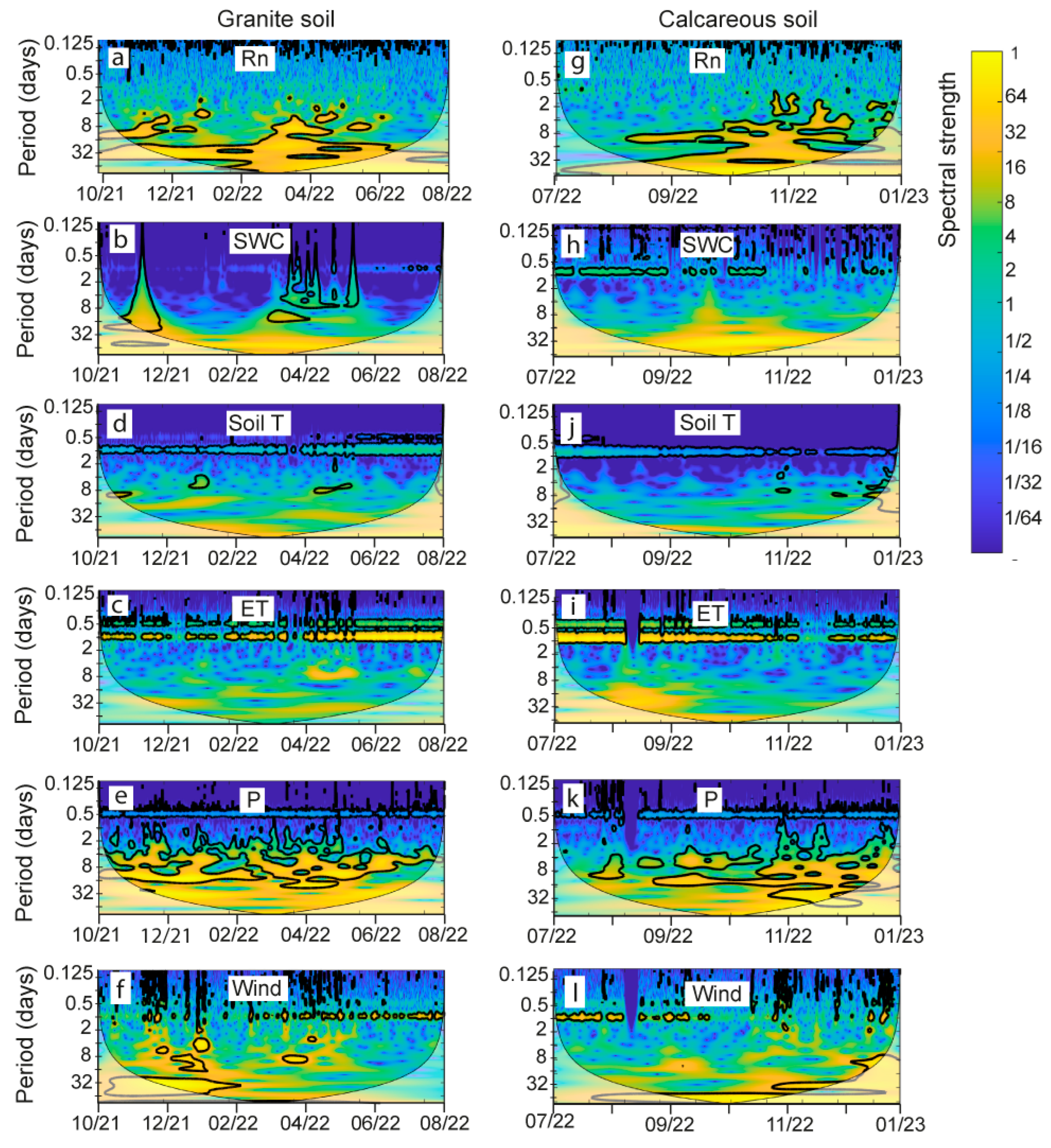
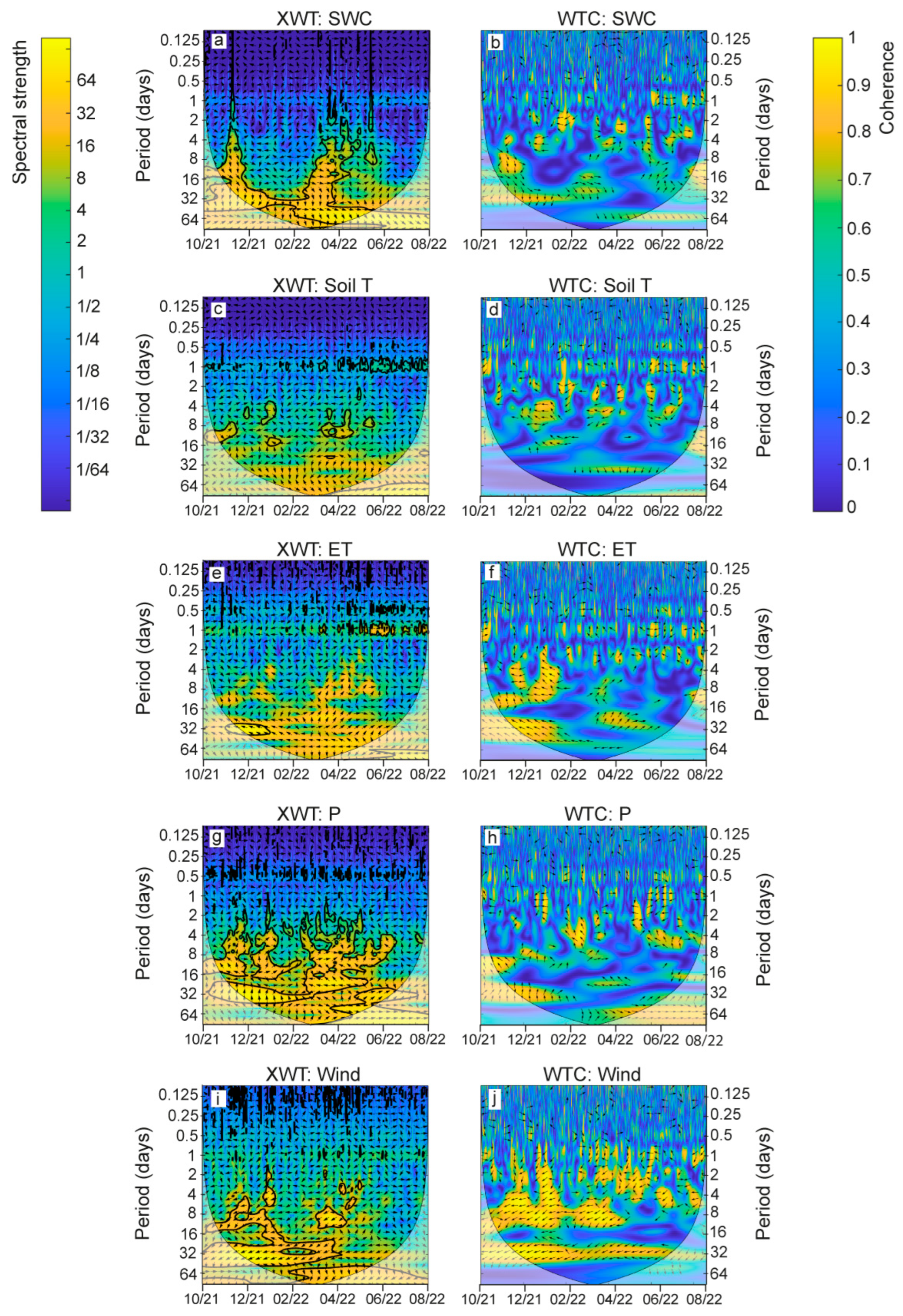
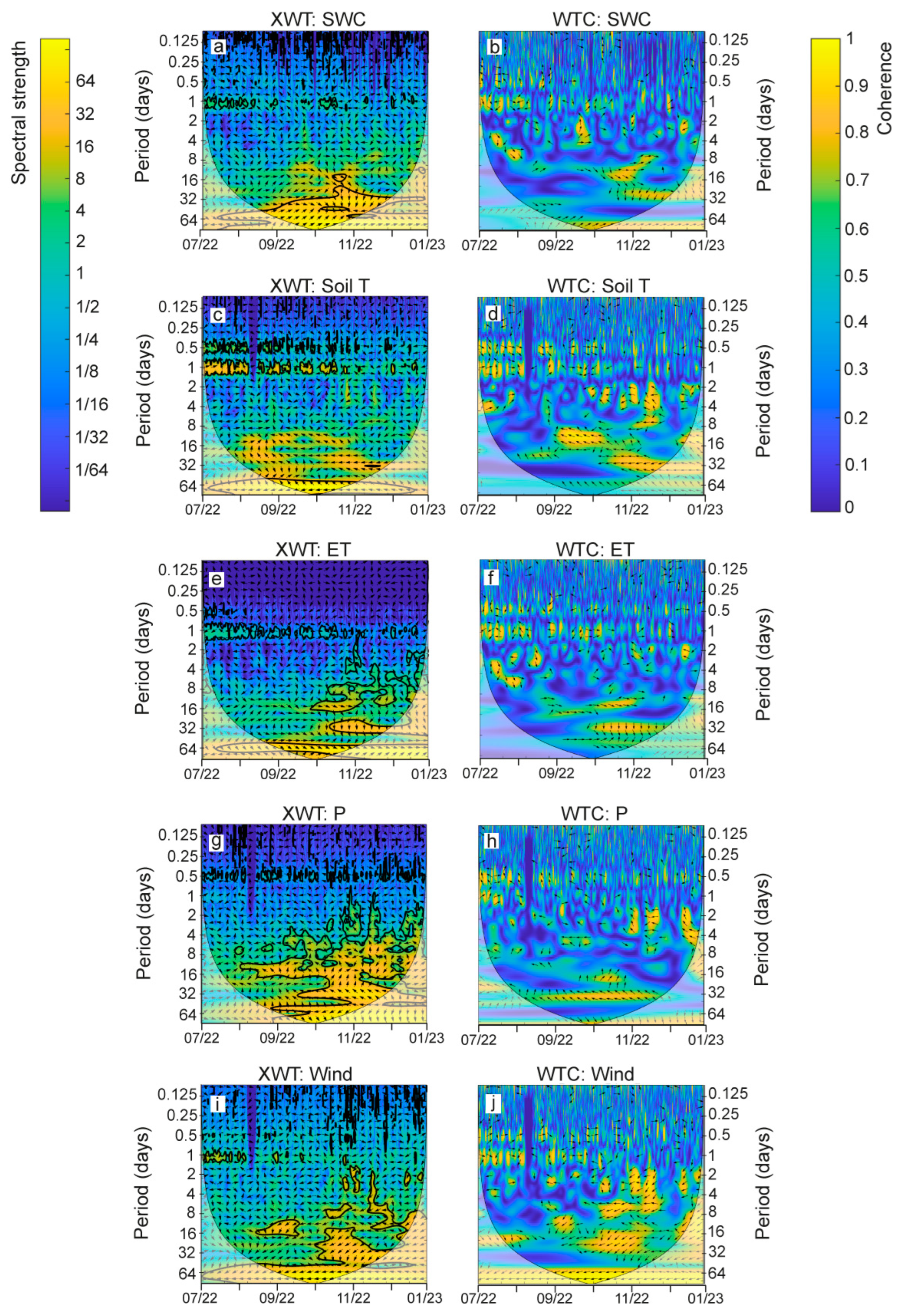

| Initial Parameters | Calcareous Soil | Granite Soil | |
|---|---|---|---|
| Layer 1 Horizon A | Layer 2 Horizon B | ||
| Bulk density (g cm−3) | 1.25 | 1.68 | 1.55 |
| Porosity (%) | 52 | 35 | 42 |
| Soil texture: | Silty clay loam | Sandy loam | Loamy sand |
| (%) sand | 18 | 72 | 80 |
| (%) silt | 51 | 22 | 14 |
| (%) clay | 31 | 6 | 6 |
| 238U (Bq kg−1) | 21.7 | 53.0 | 48.0 |
| 226Ra (Bq kg−1) | 16.9 | 39.7 | 44.4 |
| Variables | Principal Component Analysis | Multiple Linear Regression | |||
|---|---|---|---|---|---|
| PC1 | PC2 | B | Beta | p-Value | |
| Rnmax | 0.871 | −0.007 | 65,674.43 | * | |
| Rain | 0.654 | 0.225 | 77.94 | 0.31 | * |
| Rn0 | 0.702 | −0.274 | 0.34 | 0.33 | * |
| Upper SWCRn max | 0.161 | −515.95 | −0.03 | - | |
| PRn max | −0.399 | −0.652 | −58.84 | −0.35 | * |
| WindRn max | 0.024 | 0.780 | 60.63 | 0.14 | - |
| Soil TRn max | −0.456 | 0.754 | −88.78 | −0.43 | * |
| Variables | Principal Component Analysis | Multiple Linear Regression | ||||
|---|---|---|---|---|---|---|
| PC1 | PC2 | PC3 | B | Beta | p-Value | |
| Rn | −0.639 | 0.613 | 0.379 | 22,690.39 | **** | |
| Upper SWC | −0.329 | 0.890 | −0.050 | 9834.87 | 0.60 | **** |
| Soil T | 0.886 | 0.063 | 0.401 | −53.09 | −0.57 | **** |
| Wind | 0.249 | 0.245 | −0.911 | −173.26 | −0.57 | **** |
| P | −0.580 | −0.532 | 0.100 | −17.35 | −0.13 | **** |
| ET | 0.795 | 0.325 | 0.196 | 5210.02 | 0.25 | **** |
| Variables | Principal Component Analysis | Multiple Linear Regression | |||
|---|---|---|---|---|---|
| PC1 | PC2 | B | Beta | p-Value | |
| Rn | −0.499 | 0.320 | −12,020.20 | **** | |
| Upper SWC | 0.790 | 0.397 | 3982.40 | 0.19 | - |
| Soil T | 0.929 | 0.229 | −4.19 | −0.13 | - |
| Wind | 0.096 | −0.830 | 9.94 | 0.10 | - |
| P | −0.537 | 0.489 | 12.86 | 0.29 | ** |
| ET | 0.867 | −0.028 | −2128.16 | −0.28 | - |
| Coefficient | Clay | Silt | Sand |
|---|---|---|---|
| ε0 | 0.10 | 0.14 | 0.18 |
| a | 1.85 | 1.73 | 1.53 |
| b | 18.8 | 20.5 | 21.8 |
| c | 0.012 | 0.01 | 0.011 |
| Parameter | Clay | Silt | Loam | Sandy |
| Sand (%) | 5 | 5 | 42 | 90 |
| Silt (%) | 5 | 90 | 41 | 5 |
| Clay (%) | 90 | 5 | 17 | 5 |
| n | 1.20 | 1.64 | 1.44 | 2.30 |
| pkg | 12.5 | 12.3 | 12.8 | 11.4 |
Disclaimer/Publisher’s Note: The statements, opinions and data contained in all publications are solely those of the individual author(s) and contributor(s) and not of MDPI and/or the editor(s). MDPI and/or the editor(s) disclaim responsibility for any injury to people or property resulting from any ideas, methods, instructions or products referred to in the content. |
© 2024 by the authors. Licensee MDPI, Basel, Switzerland. This article is an open access article distributed under the terms and conditions of the Creative Commons Attribution (CC BY) license (https://creativecommons.org/licenses/by/4.0/).
Share and Cite
Gil-Oncina, S.; Pla, C.; Valdes-Abellan, J.; Fernandez-Cortes, A.; Benavente, D. Radon Dynamics in Granite and Calcareous Soils: Long-Term Experiments in a Semi-Arid Context. Appl. Sci. 2024, 14, 5910. https://doi.org/10.3390/app14135910
Gil-Oncina S, Pla C, Valdes-Abellan J, Fernandez-Cortes A, Benavente D. Radon Dynamics in Granite and Calcareous Soils: Long-Term Experiments in a Semi-Arid Context. Applied Sciences. 2024; 14(13):5910. https://doi.org/10.3390/app14135910
Chicago/Turabian StyleGil-Oncina, Sara, Concepcion Pla, Javier Valdes-Abellan, Angel Fernandez-Cortes, and David Benavente. 2024. "Radon Dynamics in Granite and Calcareous Soils: Long-Term Experiments in a Semi-Arid Context" Applied Sciences 14, no. 13: 5910. https://doi.org/10.3390/app14135910
APA StyleGil-Oncina, S., Pla, C., Valdes-Abellan, J., Fernandez-Cortes, A., & Benavente, D. (2024). Radon Dynamics in Granite and Calcareous Soils: Long-Term Experiments in a Semi-Arid Context. Applied Sciences, 14(13), 5910. https://doi.org/10.3390/app14135910









